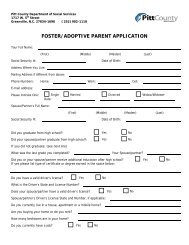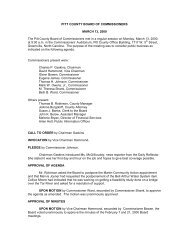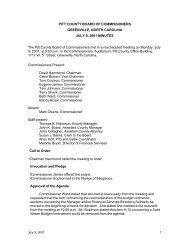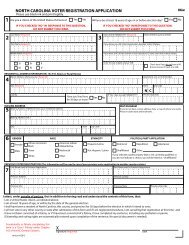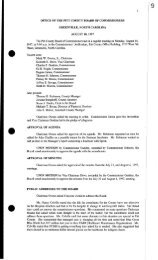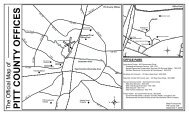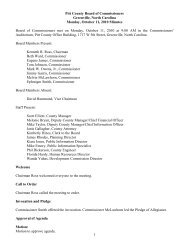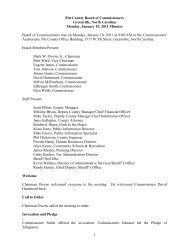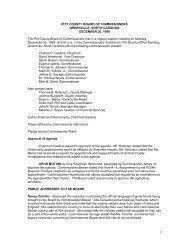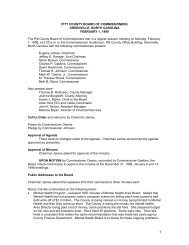2030 Comprehensive Land Use Plan - Pitt County Government
2030 Comprehensive Land Use Plan - Pitt County Government
2030 Comprehensive Land Use Plan - Pitt County Government
- No tags were found...
Create successful ePaper yourself
Turn your PDF publications into a flip-book with our unique Google optimized e-Paper software.
Flood HazardsA combination of river basin physiography, amount of precipitation, past soil moistureconditions and the degree of vegetative clearing determine the severity of a floodingevent. Protecting floodplains from inappropriate development will protect lives, reducelosses from future flood hazard events and save public dollars that would have to be spenton recovery and repair activities.The extent of flood hazard areas and the potential for destruction of lives and propertiesbecame tragically apparent in September 1999 when heavy rains associated withHurricanes Dennis I and II and Hurricane Floyd caused severe flooding in eastern NorthCarolina. Within <strong>Pitt</strong> <strong>County</strong> alone almost 3,400 residential structures were declareduninhabitable due to flood damage. Total property damages in <strong>Pitt</strong> <strong>County</strong> exceeded $346million including damages to residential structures, personal property, agriculturaloperations and public infrastructure.Debris in drainageways prior to Hurricane Floyd flooding exacerbated the flooding andstorm debris deposited by the flood waters pose an increased danger to the public. SinceHurricane Floyd, <strong>Pitt</strong> <strong>County</strong> and the Natural Resources Conservation Service have formeda partnership to provide administration for removal of storm-related debris from streamsand waterways. By the end of 2000, thirty-five miles of Contentnea Creek, LittleContentnea Creek, Bells Branch, Hardee Creek and other drainageways had been cleared.The devastation caused by Hurricane Floyd highlighted North Carolina's vulnerability tonatural disasters and the need for accurate, up-to-date floodplain maps. In 2002. the Stateof North Carolina partnered with the Federal Emergency Management Agency (FEMA) toproduce new floodplain maps for the State. This partnership designates North Carolina asa Cooperating Technical State and delegates the primary responsibility for the creation andmaintenance of all FIRMs to the State of North Carolina. In 2004, updated Flood InsuranceRate Map (FIRM) panels and a new Flood Insurance Study (FIS) Report became effectivewithin the <strong>County</strong>.The <strong>Pitt</strong> Count Multi-jurisdictional Hazard Mitigation <strong>Plan</strong> states that the hazard index forflooding is categorized as “moderate” based on a “likely to highly likely” level ofoccurrence, “medium” range of impact, and “limited” level of impact. The plan furtherindicates that floods should be a major focus of local hazard mitigation efforts within the<strong>County</strong>.<strong>2030</strong> <strong>Comprehensive</strong> <strong>Land</strong> <strong>Use</strong> <strong>Plan</strong> Appendix A: Inventory and Analysis<strong>Pitt</strong> <strong>County</strong>, North Carolina A-79



